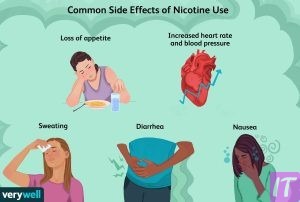What Do You Know About the Effect of Nicotine on the Body?
Nicotine, a potent stimulant found predominantly in tobacco, has a profound impact on the human body. As a widely consumed substance, it has drawn considerable attention from the scientific community and public health officials alike. Understanding the full spectrum of nicotine’s effects—from its initial chemical interaction to the long-term health consequences—is crucial for informed decision-making and effective regulation. This article delves into the myriad ways nicotine influences the body, drawing upon contemporary research and clinical insights.
Introduction to Nicotine and Its Influence on the Human Body
Nicotine is an alkaloid and the primary addictive component of tobacco products, which include cigarettes, cigars, and smokeless tobacco. Deriving its name from the tobacco plant, Nicotiana tabacum, nicotine has been utilized historically for both recreational and ceremonial purposes. The drug’s immediate effects, such as heightened alertness and a sense of relaxation, can be enticing, but these superficial benefits mask a range of harmful physiological and psychological impacts. This article systematically examines how nicotine interacts with various bodily systems, contributing to both acute and chronic health conditions.

The Chemical Composition of Nicotine
Chemically, nicotine belongs to a class of compounds known as pyridine alkaloids. Its molecular structure consists of a pyridine and a pyrrolidine ring, contributing to its ability to cross the blood-brain barrier rapidly. The presence of carbon, hydrogen, and nitrogen atoms in nicotine’s structure allows it to interact with various neurotransmitter systems. Nicotine assumes two stereoisomers, with the (S)-nicotine form being predominantly active in human physiology. Upon exposure to heat, such as when tobacco is burned, nicotine can undergo pyrolysis, yielding numerous toxic substances. Understanding nicotine’s chemical complexity is essential for grasping its full range of biological interactions.
How Nicotine Interacts with the Brain
Upon inhalation or ingestion, nicotine swiftly enters the bloodstream and reaches the brain within seconds. It binds predominantly to nicotinic acetylcholine receptors (nAChRs), particularly those in the dopaminergic pathways. This binding causes the release of various neurotransmitters, including dopamine, norepinephrine, and acetylcholine, inducing feelings of euphoria, increased concentration, and alertness. Chronic exposure leads to receptor desensitization and upregulation, fostering dependency and necessitating higher doses to achieve similar effects. The neuroadaptive changes essentially hijack the brain’s reward system, making nicotine a highly addictive substance.
The Impact of Nicotine on the Cardiovascular System
Nicotine exerts considerable effects on the cardiovascular system. It stimulates the release of catecholamines, such as adrenaline, resulting in an immediate increase in heart rate and blood pressure. Chronic nicotine intake contributes to endothelial dysfunction, a precursor to atherosclerosis, by impairing the nitric oxide pathway essential for vascular relaxation. Over time, this can lead to an elevated risk of coronary artery disease, peripheral arterial disease, and stroke. The compounded stress on the heart and blood vessels underscores nicotine’s role as a significant cardiovascular risk factor.
Nicotine and Its Effects on Respiratory Health
The respiratory system is another critical area adversely affected by nicotine, especially when inhaled through smoking. Nicotine exposure induces inflammatory responses in the lungs, exacerbating conditions like chronic bronchitis and emphysema. The ciliary function in the respiratory tract is impaired, reducing the ability to clear mucus and increase susceptibility to infections. Furthermore, the oxidative stress and carcinogens associated with nicotine-laden smoke contribute to a heightened risk of lung cancer. The detrimental impact on respiratory health is a significant concern, particularly for long-term smokers.
The Role of Nicotine in Addiction and Dependency
Nicotine is notably addictive, a property largely attributed to its rapid onset of action and prompt reinforcement of use. Upon entering the brain, it activates nicotinic receptors, inducing a release of dopamine in the nucleus accumbens, reinforcing the compulsion to consume more. Over time, tolerance develops, requiring progressively higher doses to achieve the same effects, thereby perpetuating the addiction cycle. Withdrawal symptoms, including irritability, anxiety, and cognitive impairments, further complicate cessation efforts. Understanding the neurobiological underpinnings of nicotine addiction is vital for developing effective treatment strategies.
Short-Term Physiological Effects of Nicotine Consumption
Short-term nicotine intake produces a variety of physiological responses. Notably, it leads to vasoconstriction, elevated heart rate, and increased blood pressure, placing acute stress on the cardiovascular system. Nicotine also stimulates the release of glucose from the liver, resulting in transient hyperglycemia. In the central nervous system, heightened alertness and reduced appetite are common, driven by neurotransmitter modulation. While these effects may seem benign, they lay the groundwork for more severe health issues over prolonged use.
Long-Term Health Consequences of Nicotine Use
The long-term health ramifications of nicotine use are extensive and multi-faceted. Prolonged exposure significantly increases the risk of developing chronic conditions such as cardiovascular disease, pulmonary disorders, and various cancers. Additionally, there are detrimental effects on oral health, including gum disease and tooth loss. Compounding these issues, nicotine exacerbates insulin resistance, contributing to the development of type 2 diabetes. The cumulative impact of these health challenges underscores the importance of addressing nicotine addiction comprehensively.
Nicotine and Its Influence on Metabolism
Nicotine is known to impact metabolic processes. It increases the basal metabolic rate, partly due to its stimulatory effects on the sympathetic nervous system. This can lead to a temporary, modest increase in calorie expenditure. However, nicotine also alters lipid metabolism, leading to dyslipidemia characterized by elevated levels of low-density lipoprotein (LDL) cholesterol and reduced high-density lipoprotein (HDL) cholesterol. These changes contribute to an increased risk of metabolic syndrome and cardiovascular complications.

The Relationship Between Nicotine and Mental Health
Nicotine’s interaction with the brain extends beyond addiction, influencing overall mental health. While initially providing a sense of relaxation and stress relief, chronic use is associated with heightened risks of mood disorders such as depression and anxiety. The disruptions in neurotransmitter systems and neural plasticity may underlie these associations. Moreover, individuals with pre-existing mental health conditions may be more vulnerable to nicotine dependence, creating a cyclical relationship that complicates both mental health management and cessation efforts.
How Nicotine Affects the Immune System
The immune system is not spared from nicotine’s adverse effects. Nicotine impairs both innate and adaptive immune responses. It reduces the activity of neutrophils and macrophages, key players in the body’s initial defense against pathogens. This immunosuppressive effect increases vulnerability to respiratory infections and delays wound healing. Furthermore, chronic nicotine exposure can alter cytokine profiles, promoting a pro-inflammatory state that exacerbates autoimmune conditions. The destabilizing impact on immune function has far-reaching health consequences.
The Effects of Nicotine on Hormonal Balance
Nicotine influences the endocrine system, affecting hormonal balance. It stimulates the release of catecholamines from the adrenal glands, impacting the body’s stress response. Additionally, nicotine can alter thyroid hormone levels, potentially leading to metabolic dysregulation. In female users, nicotine has been shown to interfere with estrogen synthesis, influencing reproductive health and menstrual cycles. These hormonal imbalances contribute to a wide array of systemic health issues, further illustrating the pervasive impact of nicotine.
Nicotine Use During Pregnancy: Risks and Complications
Nicotine use during pregnancy poses significant risks to both the mother and the developing fetus. Nicotine readily crosses the placenta, reducing blood flow and oxygen delivery to the fetus. This can result in intrauterine growth restriction, preterm birth, and low birth weight. The likelihood of congenital anomalies and developmental delays is also increased. Additionally, there is an elevated risk of Sudden Infant Death Syndrome (SIDS). The comprehensive spectrum of prenatal complications underscores the critical need for smoking cessation programs for expectant mothers.
Understanding Nicotine Withdrawal Symptoms
Nicotine withdrawal is a significant barrier to successful cessation. Symptoms typically manifest within a few hours of the last dose and peak within the first few days. Common symptoms include irritability, anxiety, difficulty concentrating, increased appetite, and strong cravings for nicotine. These symptoms are driven by the brain’s adjustment to the absence of nicotine-induced neurotransmitter release. Effective management of withdrawal symptoms often requires a combination of pharmacological and behavioral interventions to support sustained abstinence.
E-cigarettes and Vaping: A Modern Source of Nicotine
E-cigarettes and vaping devices have emerged as contemporary sources of nicotine, marketed as safer alternatives to traditional smoking. These devices deliver nicotine through aerosolized vapor, which still contains various harmful substances, albeit at lower levels than tobacco smoke. The long-term health impacts of vaping remain a subject of ongoing research, with concerns about respiratory, cardiovascular, and neurological effects continuing to surface. The growing popularity of these products, particularly among youth, presents new public health challenges.

The Economic and Social Implications of Nicotine Addiction
Nicotine addiction has profound economic and social ramifications. The healthcare costs associated with treating nicotine-related illnesses are substantial, placing a considerable burden on public health systems. Additionally, loss of productivity due to nicotine-related health issues affects economic output. Socially, nicotine addiction can lead to stigmatization and impaired quality of life. The broad societal impacts underscore the necessity of comprehensive strategies to address nicotine use and support affected individuals.
Strategies for Quitting Nicotine: Treatments and Therapies
Effective strategies for quitting nicotine encompass a range of pharmacological and behavioral interventions. Nicotine replacement therapies (NRTs), such as patches, gum, and lozenges, help alleviate withdrawal symptoms by providing controlled doses of nicotine. Prescription medications like varenicline and bupropion offer alternative pharmacological support by targeting the neural pathways involved in addiction. Behavioral therapies, including cognitive-behavioral therapy (CBT) and motivational interviewing, play crucial roles in addressing the psychological aspects of nicotine dependence. Tailored, multi-faceted approaches are often needed for sustained cessation.
The Role of Public Health Initiatives in Nicotine Control
Public health initiatives are vital in controlling nicotine use and reducing its associated health burdens. Key strategies include public education campaigns, which raise awareness about the dangers of nicotine and support for smoking cessation programs. Policy measures, such as taxation, plain packaging, and advertising restrictions on tobacco products, also play critical roles. Additionally, legislation to limit the sale and distribution of nicotine products, especially to minors, is essential. Collaborative efforts between governmental and non-governmental organizations can amplify these initiatives’ effectiveness.
Comparative Analysis of Nicotine and Other Stimulants
Nicotine, while a potent stimulant, differs from other stimulants such as caffeine and amphetamines in several respects. Unlike caffeine, which primarily affects adenosine receptors, nicotine interacts with nicotinic acetylcholine receptors, leading to distinct physiological and addictive profiles. Compared to amphetamines, nicotine’s stimulant effects are generally milder but more insidious due to its high addictive potential and widespread use. Understanding these differences is crucial for contextualizing nicotine’s unique health impacts and developing targeted interventions.
Future Research Trends on Nicotine and Health
Future research on nicotine and health is likely to focus on several key areas. Understanding the long-term effects of alternative nicotine delivery systems, such as e-cigarettes, remains a priority. Advances in genetic research may provide insights into individual susceptibility to nicotine addiction and response to treatments. Additionally, exploring the complex interactions between nicotine and co-occurring mental health conditions could yield more effective, personalized cessation strategies. As public health priorities evolve, robust research will continue to inform and enhance nicotine control measures.
In conclusion, nicotine exerts a broad spectrum of detrimental effects on the body, impacting the cardiovascular, respiratory, and immune systems, among others. Its addictive nature complicates

Please! Don’t Forget To Leave A Comments For us 🙂







